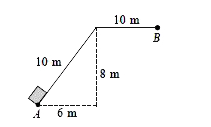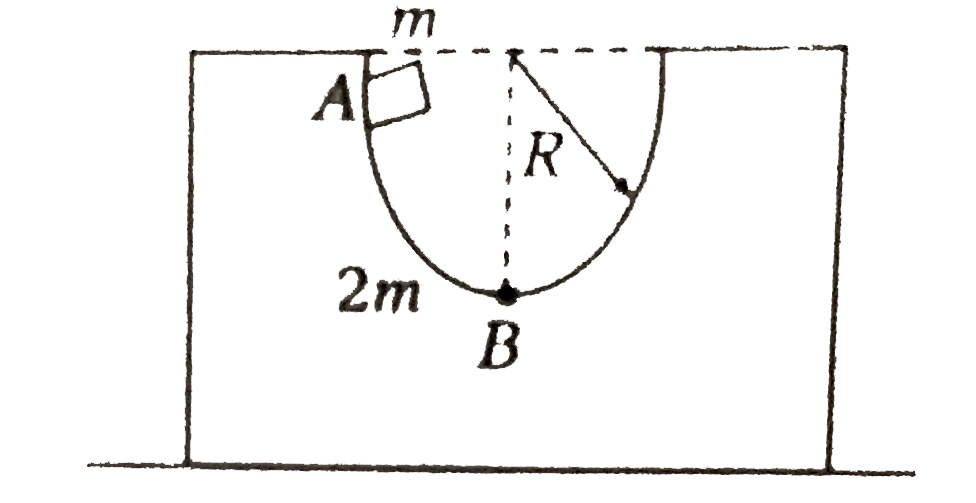A particle is released at point A. Find Kinetic energy at point P Given m = 1 kg and all surfaces are frictionless

The correct Answer is:10 J
Step by step video & image solution for A particle is released at point A. Find Kinetic energy at point P Given m = 1 kg and all surfaces are frictionless by Physics experts to help you in doubts & scoring excellent marks in Class 12 exams.
Updated on:21/07/2023Topper's Solved these Questions
Similar Questions
A box of 5 kg mass moves up a ramp from point A to point B at a constant speed. Given that the surfaces are smooth (frictionless). What is the gain in the potential energy by the box? (Take g = 10 m/s2)

View SolutionA thin uniform bar lies on a frictionless horizontal surface and is free to move in any way on the surface. Its mass is 0.16 kg and lengths is √3m. Two particles, each of mass 0.08kg, are moving on the same surface and towards the bar in a direction perpendicular to the bar, one with a velocity of 10ms−1 and the other with 6ms−1, as shown in fig. The first particle strikes the bar at point A and the other at point B. Points A and B are at a distance 0.5 m from the centre of the bar. The particles strike the bar at same instant of time and stick to the bar on collision. Calculate the loss of kinetic energy of the system in the above collision process.

View Solution
Knowledge Check
A particle of mass m has momentum p. Its kinetic energy will be
AmpBp2mC(p2mDp22mA block of mass 1 kg is released from the top of a wedge of mass 2 kg. Height of wedge is 10 meter and all the surfaces are frictionless. Then
 ADisplacement of centre of mass of system in vertical direction is zero.BDisplacement of centre of mass of system, vertically downwards, is 103m,CRation of normal reaction between block and wedge to the acceleration of wedge w.r.t ground is 4 (in kg).DMomentum of system will not be conserved in horizontal direction.
ADisplacement of centre of mass of system in vertical direction is zero.BDisplacement of centre of mass of system, vertically downwards, is 103m,CRation of normal reaction between block and wedge to the acceleration of wedge w.r.t ground is 4 (in kg).DMomentum of system will not be conserved in horizontal direction.A particle is projected at 60∘ to the horizontal with kinetic energy K. Its kinetic energy at the highest point is :
AKBzeroCK4DK2
In a region of space an electric field line is in the shape of a semicircle of radius R. Magnitude of the field at all point is E. A particle of mass m having charge q is constrained to move along this field line. The particle is released from rest at A. (a) Find its kinetic energy when it reaches point B. (b) Find the acceleration of the particle when it is at midpoint of the path from A to B.

View SolutionA thin uniform bar lies on a frictionless horizonta surface and is free to move in any way on th surface. Its mass is 0.16 kg and length √3meters. Two particless, each of mass 0.08 kg, are moving on the same surface and towards the bar in a direction perpendicular to the bar, one with a velocity of 10 m/s, and other with 6m/s as shown in fig. The first particle strikes the bar at point A and the other at point B. Points A and B are at a distane of 0.5m from the centre of the bar. The particles strike the bar at the same instant of time and stick to the bar on collision. Calculate the loss of the kinetic energy of the system in the above collision process.

View SolutionIn the system shown in figure, mass m is released from rest from position A. Suppose potential energy of m at point A with respect to point B is E. Volume of m is negligible and all surfaces are smooth. When mass m reaches at point B

column IcolumnII(A)Kinetic Energy of m(P)E/3(B)Kinetic Energy of 2m (Q)2E/3(C)Momentum of m(R)√43mE(D)Momentum of 2m(S)√23mE(T)None
View SolutionIn the system shown in figure, mass m is released from rest from position A. Potential energy of m at point A with respect to point B is E. Volume of m is negligible and all surfaces are smooth. When mass m reaches at point B.

View SolutionIn the system shown in figure, mass m is released from rest from position A. Suppose potential energy of m at point A with respect to point B is E. Dimensions of m negligible and all surfaces are smooth. When mass reaches at point B.

View Solution
